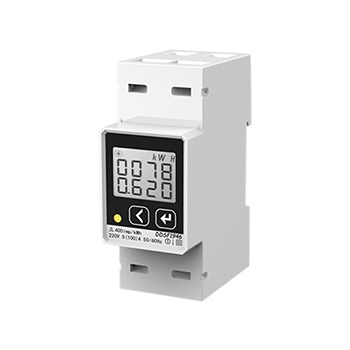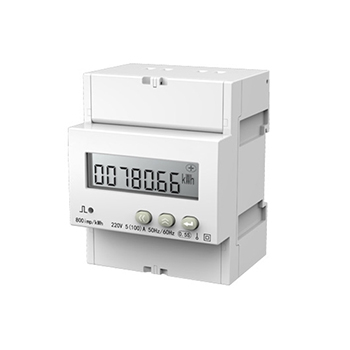How do Digital Energy Meters Work?
With the development of electronic technology, the standard energy meter has also realized the transformation to digital and intelligent. Compared with traditional mechanical energy meters, electronic energy meters have various advantages such as high measurement accuracy, low power consumption, and strong anti-stealing capabilities. So, what is the working principle of the electronic energy meter? What function does it have?
Type of energy smart meters
Electric energy meters are divided into electromechanical electric energy meters and electronic electric energy meters. Electromechanical electric energy meters use changes in electromotive force to convert changes in parameters such as current and voltage into mechanical energy, and then measure the consumed electric energy through the mechanical system. The electronic energy meter uses electronic components such as analog circuits, digital circuits, and microprocessors to measure changes in parameters such as voltage and current, and calculate the consumed electric energy.
Function
The electronic energy meter consists of two main functions: one is the electric energy measurement part, and the other is the microprocessor control part. The energy measurement part of the electric energy meter uses a large-scale application-specific integrated circuit to generate a pulse sequence indicating the amount of electricity used, and sends it to the microprocessor for energy measurement. After the microprocessor receives the pulse signal, it accumulates the number of input pulses, and realizes the precise measurement of electric energy according to the pulse constant, and transmits data through various interfaces to realize various control functions.
The energy meter can also be used to measure the change of power factor. It can display data such as voltage, current, power factor and active power in real time, so that it is convenient for managers to control power consumption, thereby improving the efficiency of power utilization.
How it work?
In a circuit, changes in voltage and current produce a certain amount of power, and the accumulation of power produces electrical energy, which is consumed. Therefore, the electric energy meter is an instrument that calculates electric energy by measuring changes in voltage and current.
An electric energy meter is an electrical instrument used to measure electrical energy. Its working principle is based on the induction of a magnetic field. The main components of the electric energy meter include current coil, voltage coil, iron core, turntable, counting mechanism, etc. When current passes through the current coil, it creates a magnetic field whose magnitude is proportional to the magnitude of the current. At the same time, when the alternating current passes through the voltage coil, an alternating electric field will be generated, and the magnitude of this electric field is proportional to the magnitude of the voltage.
Due to the existence of the iron core, the magnetic and electric fields of the current coil and the voltage coil will affect each other, thereby generating a magnetic flux inside the iron core. The magnitude of this magnetic flux is proportional to the magnitude of the current and voltage. The turntable is the core part of the electric energy meter, and it can rotate under the action of a magnetic field. When the power meter is powered on, the turntable will rotate with the change of current and voltage, so as to realize the measurement of electric energy. The measurement results are recorded and displayed by the counting mechanism.
In short, the working principle of the 1 phase DIN-rail energy meter is based on the induction principle of the magnetic field, using the interaction between the magnetic field and the electric field generated by the current coil and the voltage coil to generate a magnetic flux inside the iron core, thereby realizing the measurement of electric energy.
Working characteristics of smart meters
Smart meters adopt the design of electronic integrated circuits, so compared with inductive meters, smart meters have great advantages in terms of performance and operational functions.
- Power consumption. Since the smart meter adopts the design method of electronic components, the power consumption of each meter is generally only about 0.6-0.7W. For the multi-user centralized smart meter, the average power per household is even smaller. Generally, the power consumption of each inductive meter is about 1.7W.
- Accuracy. As far as the error range of the electric energy meter is concerned, the error measured by the 2.0-level electronic electric energy meter in the range of 5% to 400% of the calibrated current is ±2%, and the accuracy level is generally used at present with an accuracy level of 1.0, and the error is smaller. The error range of the single phase LCD display energy meter is 0.86% to 5.7%, and due to the insurmountable defect of mechanical wear and tear, the inductive energy meter is getting slower and slower, and the final error is getting bigger and bigger. More than 50% of the inductive meters have exceeded the allowable range after 5 years of use.
- Overload. Power frequency range. The overload multiple of the smart meter can generally reach 6 to 8 times, and it has a wide range. At present, electric energy meters with a ratio of 8 to 10 are becoming the choice of more and more users, and some can even reach a wide range of 20 ratios. The operating frequency is also wide, ranging from 40 to 1000Hz. The overload multiple of the inductive meter is generally only 4 times, and the working frequency range is only 45-55Hz.
- Function. Due to the use of electronic technology, the smart meter can be connected to the computer through the relevant communication protocol, and the control and management of the hardware can be realized through the programming software. Therefore, the smart meter not only has the characteristics of small size, but also has functions such as remote control, multi-rate, identification of vicious loads, anti-stealing electricity, prepaid fees and can meet the requirements for control functions by modifying different parameters in the control software. These functions are difficult or impossible for traditional inductive meters.

